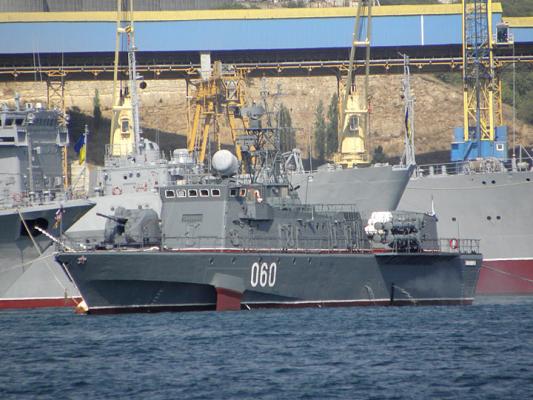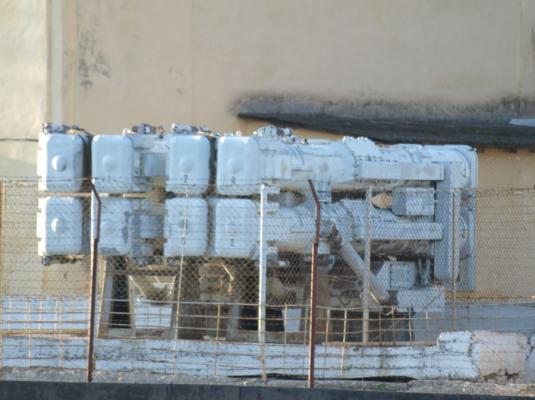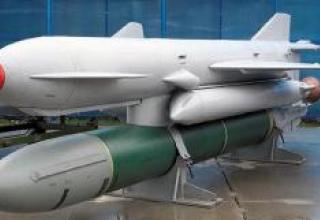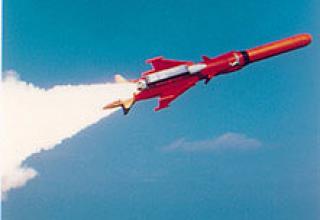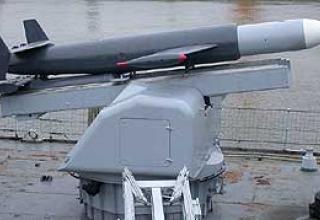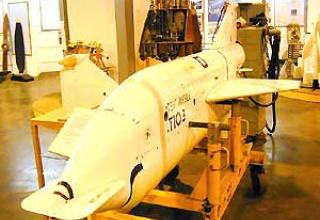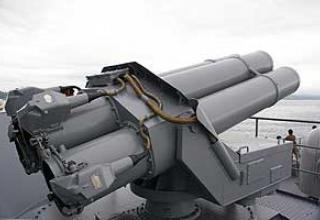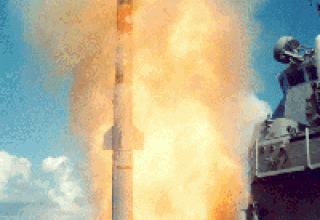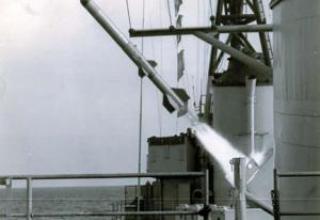Small-size anti-submarine missile system RPK-9 "Medvedka" is designed to arm surface ships with displacement from 350 tons, including ships with dynamic principles of maintenance, in order to destroy submarines, mines and anti-submarine fences.
The development of the RPK-9 complex (originally called "Metelitsa") began in the 80s of last century at the Moscow Institute of Heat Engineering under the guidance of Chief Designer N. Mazurov. The small-size self-guided torpedo MPT-1UE developed by the Central Research Institute "Gidropribor" (St. Petersburg) was used as a warhead of the missile. The firing control complex is produced by the concern "Granit-Electron" (St. Petersburg). Mass production of the anti-submarine missile 87P from the complex was mastered at the State Enterprise "Votkinsky plant".
The tests were carried out on a small hydrofoil winged anti-submarine ship of project 1141 "Alexander Kunakhovich" on the Black Sea, aft of which two quadruple launchers were installed (see photo). In summer 2000, the complex was dismantled from the ship and placed on shore.
The modernized version of the complex, designated "Medvedka-2", is part of the frigates 22350, which are being built at the "Northern Shipyards" in St. Petersburg. Transfer to the fleet of the head ship of this project "Admiral of the Fleet of the Soviet Union Sergey Gorshkov" - 2011.
At present, the RPK-9 complex is offered for export; according to NATO classification, it was designated SS-N-29.
Composition:
The composition of the complex:
- Anti-submarine missile 87R with a warhead - torpedo MPT-1UE;
- launcher;
- loading device;
- firing control system;
- power supply system;
- ground equipment set;
- training means;
- set of spare parts, tools, accessories and materials.
The 87P anti-submarine missile (see diagram) consists of a solid propulsion system and a warhead, including a range control unit and a small-size anti-submarine torpedo with a braking and stabilization system (BS). Control of the missile by the range is carried out by zeroing the engine thrust with its separation when the calculated range is reached, which is calculated by the firing control system and entered into the missile before launch. After separation of the engine, the torpedo is lowered into the water by parachute. The rocket is not controlled by the azimuth. The accuracy of firing in this direction is ensured by the choice of the starting moment when the firing line coincides with the direction to the target. Realized in the complex sighting scheme and algorithms of generating the launch torque stipulate high accuracy characteristics when firing from unstabilized PU. Aerodynamic stability of rockets in the air part of the trajectory is provided by stabilizers, which open when the rocket leaves the launcher.
The combat unit of missile 87R - torpedo MPT-1UE with a braking and stabilization system (STS). MPT-1UE torpedo is designed to combat submarines with a cruising speed of up to 35 knots at a diving depth of 15 to 600 meters. The torpedo is equipped with an acoustic homing system that allows salvo use and provides guidance to low-noise submarines using acoustic countermeasures devices. Control system on course and depth leads the torpedo to the target with the necessary accuracy, and the combat charging compartment ensures the destruction of the submarine as a direct hit, and when the torpedo passes the target. The torpedo is equipped with a powerful axial piston engine on unitary fuel, reliable and safe in operation by placing the fuel in an ampoule tank. The torpedo does not require maintenance when stored in a container at temperatures ranging from - 50 ° to + 50 ° C for 10 years. To ensure combat training the torpedo is used in the training version, which allows to obtain the necessary information in case of repeated use. Modular design allows to upgrade the torpedo according to the customer's requirements (for example, to increase range, to use against surface ships). Design features of the complex allow for the use of other torpedoes of the same class, such as the torpedo type Mk-46. Complete delivery of BC is possible, allowing to use it from aircraft carriers (planes, helicopters).
Launching unit (PU) of the complex - nonstabilized, lifting with a sloping start. The PU is a package of four barrels enclosed in a common clip, made of light aluminum alloy (see photo). Its main feature is the absence of vertical and horizontal guidance in the design of power tracking drives, which provides a small weight-size characteristics. The starter unit can be made in a two-barrel version. It is possible to place the PU on the coastal starting position. For large displacement ships, a version of the guided PU on a swivel base has been developed.
An upgraded version of the Medvedka-2 complex has been developed to accommodate and launch missiles from the ships' vertical launchers. The vertical launch rocket uses a new autonomous control system compartment, which uses a block of command devices, on-board computer, steering drive and other elements from the composition of other products currently in mass production. The missile is launched using a powder pressure accumulator from the transport and launch container by means of a mortar circuit, which reduces the gas-dynamic impact on the carrier ship structures. After leaving the container, the missile makes a U-turn towards the target, after which the marching rocket engine is activated. The Medvedka-2 complex is part of the frigates of the 22350 project.
The firing control system is designed to control the ship's anti-submarine weapons and provides control of single and multiple launch (up to 4 in a salvo) firing of rockets from two four-pipe launchers against submarines (the current target location, the predicted point and the area of possible target position), mine and anti-submarine fences.
The complex solves the following functional tasks:
- automatic data reception from LAG, pointer and gyrocompass
- automatic or manual input of target designation and meteorological data
- target production
- generation of firing data at the present and forecasted target location and by possible target location area
- Determining the probability of impact and making recommendations on the number of missiles assigned to the volley
- control of launchers (fixed angle lifting, opening and closing covers, lowering)
- display on the control panel all information about the progress of pre-start preparation
- course development
- starting torque detection
- input and control of firing data entry through main and reserve channels
- rocket data storage
- documenting
- personnel training
- accidental release of rockets (battery powered)
The complex can be used in any climatic conditions, sea disturbance up to 6 points and in the whole speed range of the carrier ship. Ready to start time - 15s (without taking into account the pointing time and from the moment of receiving data about a target at the submitted supply voltage and at the accelerated methods of firing).
Characteristics:
| Range of fire, km: - maximum - minimum |
20.5 1.6 |
| Depth of target, m | 16 — 600 |
| The dimensions of the rocket, mm: - length - diameter |
5500 400 |
| Missile launch weight, kg | 800 |
| Torpedo MPT-1UE (MPT-1UME) | |
| Dimensions, mm: - Length from STS - Length without STS - caliber |
3050 2900 324 |
| Weight, kg | 285 |
| Weight of BB in TNT equivalent, kg | 60 |
| launcher | |
| Number of trunks | 2 or 4 |
| Inner barrel diameter, mm | 440 |
| Weight with 4 missiles, kg. | 9200 |
| Dimensions in walking distance, mm: - length - width - altitude |
5800 1900 2400 |
| Number of rockets in salvo | up to 4 |
| Rate of fire in the volley, s | 6 |
| Personal composition: - firing control operator - catering staff - 2 persons |
1 2 |
| Shooting control complex | |
| Ready to fire, s | 15 |
| Continuous operating time, hour. | no more than 24 |
| Average service life before factory repair | 10 years |
| Total service life | 25 years |
| Weight, kg | no more than 1000 |
| Input power, kW: - from single-phase network 220V, 400Hz - from a single-phase network 220V, 50Hz - from a 27V DC mains supply (from the battery) |
8 0.5 up to 1 |
Testing:
As of 01.01.1950, the factory batch of 230 shells was completed and sent to the Pavlograd test site.
In November 1949, pre-factory tests of 34 shells were carried out together with the fuse B-377 during which cases of missiles were revealed.
Special tests carried out to determine the causes of deficits showed that the most probable cause was an increased release of unburned reactive charge particles at the end of the active section of the trajectory.
In order to eliminate this phenomenon, in December 1949 a bench-top refinement of the engine was started with regard to aperture enhancement and ensuring that the powder charge was fixed in the chamber. After the end of the bench work and experimental firing for checking the reinforced aperture, the factory batch of projectiles was to be equipped with modified apertures on site and presented for factory tests in February 1950.

